The 5-Star Customer Support Course teaches the “light” technical training that CSRs and other office staff need to know to function at their highest level.
What makes a business grow? There are a lot of potential answers for this but one common element that successful businesses always have is excellent customer support.
Makes sense doesn’t it? A company could have the best techs in the world, but if the initial contact doesn’t go well, the jobs aren’t going to be scheduled.

Amazing customer service is the golden foundation on which most successful businesses are built on. And it goes beyond that critical first impression.
A truly great customer service representative will not only have a friendly demeanor, but also enough knowledge of appliance operations and repair so they can ask the right questions, give the right advice, and get the information that the technician will need to optimize the outcome of the service call.
This kind of skill doesn’t come out of nowhere. Service reps need to be well trained. And that is exactly what Master Samurai Tech’s new 5-Star Customer Support course provides.
Here are just some of the key skills that a graduate of this course will have:
- Know what questions to ask based on what the customers are reporting
- Give usage tips that might solve the problem without needing a service call
- Collect accurate information to pass on to the technician
- Identify issues that must be addressed by other means before sending an appliance technician
- Be able to take control of the call politely in order to gather information efficiently

Like all MST courses, 5-Star Customer Support is all online and self-paced.
Each lesson ends with a quiz. The quizzes are graded automatically so the student gets immediate feedback on how they did and can try again to perfect their understanding of the material.
Most lessons also have printable study sheets to help the students remember what they have learned and create a valuable reference book for the future.
Here is a complete list of the topics covered in the course:

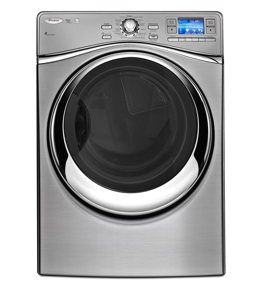 As students work through the course they will expand their knowledge of how appliances operate. We also provide lists of common questions to ask customers in order to get the critical information needed to optimize the outcome of the service call.
As students work through the course they will expand their knowledge of how appliances operate. We also provide lists of common questions to ask customers in order to get the critical information needed to optimize the outcome of the service call.
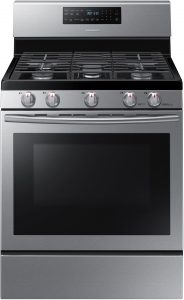 The goal of the course is to help your company’s service reps be worth their weight in gold. They are the face of your company and should give the best possible impression to customers. With a well-trained, polite, and confident CSR, the 5-star reviews will come flooding in. They will save your company time and money by boosting service call efficiency and will build a flock of loyal, enthusiastic customers.
The goal of the course is to help your company’s service reps be worth their weight in gold. They are the face of your company and should give the best possible impression to customers. With a well-trained, polite, and confident CSR, the 5-star reviews will come flooding in. They will save your company time and money by boosting service call efficiency and will build a flock of loyal, enthusiastic customers.
Click here to enroll in the 5-Star Customer Support course.
SAMPLE 1
Here’s a section of the Basic Electricity lesson. We start with a very basic overview of how electricity and circuits, so that the CSR has a feel for the type of troubleshooting that an appliance tech does. Even if a CSR will never step foot in a customer’s home, the more he or she understands about appliance repair, the more effective they’ll be.
We then teach some practical items related to household power supply and GFCI outlets that sometimes influence the conversation a CSR has with a customer:
Household Power Supply
One last item in the realm of electricity that you should know a little about is the power that comes into our homes.
In North America, our normal residential electrical wall outlets supply 120 volts (V). Most appliances are plugged into these types of outlets and run on 120V.
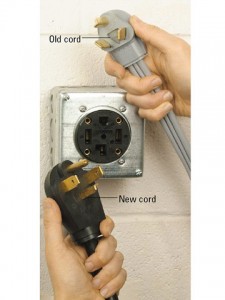
Two styles of dryer cords and a 240V outlet
However, if you have an electric dryer or range, then you have probably seen cords or outlets that look something like this:
That is because these two types of appliances need 240V to operate. In order to deliver 240V to that special outlet, two lines of 120V electrical service will be run from the circuit box to the outlet. This means that there are two circuit breakers for that outlet, not just one.
GFCI outlets
Most homes now have outlets that look like this in certain areas of their homes, especially bathrooms.
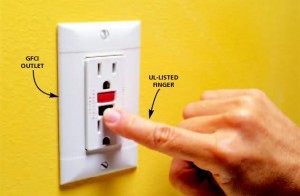
These GFCI outlets protect against electrical shock in the event that a person in a wet environment (such as the bathroom) accidentally gets exposed to electrical current. That’s a good thing! However, anyone who has used these types of outlets knows that they can sometimes “trip” and cut power to the outlet, even when there hasn’t been an actual dangerous situation. This is usually just a nuisance, but occasionally appliances are plugged into a GFCI outlet and that can cause the appliance to suddenly stop functioning. You can see why it would be a very bad idea to have a refrigerator plugged into a GFCI outlet!
SAMPLE 2
This is one of the units from the Refrigerators Module, that gives an overview of the Refrigeration System. Again, the focus is on helping the CSR know enough about the operation of a refrigerator to understand what information is important to give to the technician, and what questions or advice to give to the customer.
The Refrigeration System
Now we’re going to go into a little more detail about each of the four areas of operation (refrigeration, air distribution, defrost system, and control system), beginning with the Refrigeration System.
Before we move on, a little note about terminology. The whole appliance is called a refrigerator, of course, but there are two compartments – the freezer and the … refrigerator. That’s a little confusing sometimes, so we often call the compartment that you keep your non-frozen foods in the fresh-food compartment to be clear. We’ll try to be consistent throughout the course with that terminology.
As you saw in the video in the previous unit, the refrigeration system is also called the sealed system. It is made up of three components: the compressor, the condenser coils, and the evaporator coils. These are all connected, filled with refrigerant, and completely sealed off from the atmosphere.
Refrigerant is a chemical that has special properties that, when it is moved through the sealed system, results in cooling. Some people still call refrigerant Freon (also called R12), but that particular one is no longer used due to alleged environmental effects. The industry standard refrigerants are currently R134-A or R600.

The compressor compartment at the back of the fridge
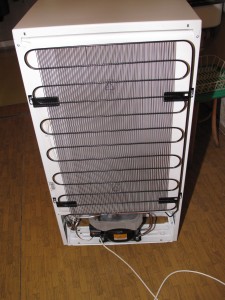
Condenser on back
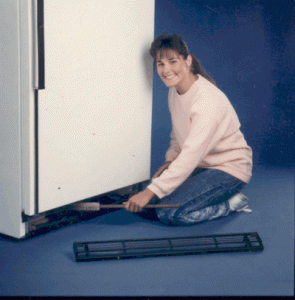
Having fun cleaning the condenser at the bottom of the fridge.
The evaporator coils are located behind the freezer wall and become extremely cold due to the way the refrigerant behaves when it passes through. A fan (called the evaporator fan) blows air across these coils and then into the freezer, keeping our ice cream nice and firm!
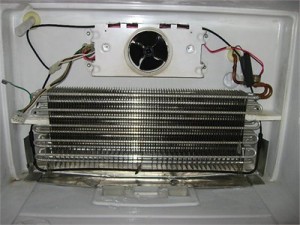
Lurking behind your freezer wall – the evaporator coils!
Most household refrigerators until recently are what we call single-evaporator refrigerators. They just have the evaporator behind the freezer creating the cold air, which is then shared with the fresh food compartment through the damper to keep it cold. However, we are starting to see more dual-evaporator models on the market now, and they have an additional evaporator just for the fresh-food compartment. We’ll have a unit just on those a little later on.
You may wonder why the movement of a special chemical through some tubing causes such dramatic temperature effects. It’s all based on a special field of science called thermodynamics, but all you have to think about is what happens when you have a little moisture on your skin and a breeze comes your way. The air movement causes that moisture to evaporate on the surface of your skin which drops the temperature rapidly and gives you a sudden chill. Refrigeration engineers figured out how to harness this type of action in the sealed system so that these boxes would do our chilly bidding!
Problems with the refrigeration system will usually result in warming temperatures. But here are some additional notable symptoms regarding the Refrigeration System that your customer may hear, feel, or see:
Compressor: most compressors make an audible hum when they are running. Homeowners often get used to hearing them periodically. Notable: the noise is absent, more frequent, accompanied by a clicking sound, and/or louder than normal.
Condenser coils: usually at the bottom of the refrigerator. If a customer has a warming refrigerator and sees a lot of dust and debris built up on them, they should clean them first to see if that improves the performance.
The notable symptoms for the fans will be covered in the next unit.
— End of Sample —
[At this point, the student is given a downloadable study sheet to fill out, and then a quiz to take, which is automatically graded.]
Click here to enroll in the 5-Star Customer Support course.